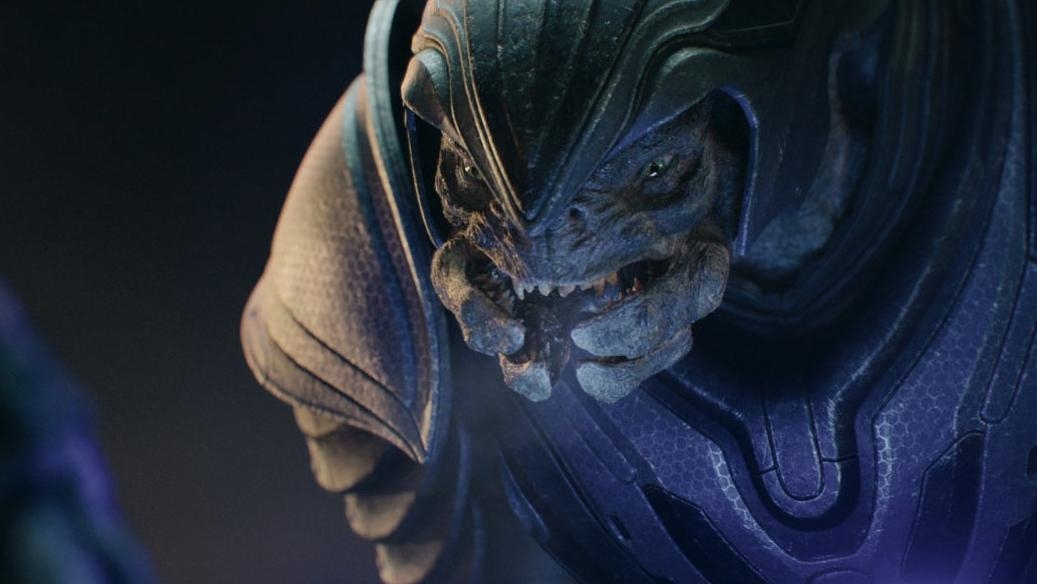Paramount Plus' tepid Halo adaptation has a surprising mean streak
Stars Pablo Schreiber and Yerin Ha do their best, but Halo isn't Game Of The Year material

A couple of years back—that is, when the casting new first broke—The A.V. Club ran a Newswire headline summing up the paradox inherent to the series that would eventually become Paramount+’s Halo: “Interesting actor Pablo Schreiber to play boring hero Master Chief.” Three years later, those words have turned at least somewhat prophetic: Schreiber is, indeed, the most interesting thing about Halo—which isn’t necessarily saying all that much.
Set, loosely, in a video game universe that’s already sold about a billion Xboxes and counting, the series centers on Schreiber as SPARTAN Master Chief John-117, a semi-soulless super soldier deployed as a killing machine by the ruthless military of the UNSC, a space-based coalition of quasi-fascists that finds itself waging a civil war against human separatists on one rifle-toting hand, and a dogmatic race of technologically advanced aliens, the Covenant, on the other.
On first (helmeted) blush, John and his fellow SPARTANs come off as mechanical, deadly, and literally faceless—their rarely removed masks being one of about a dozen things that will remind audiences of Disney+’s superior The Mandalorian. Credit where it’s due, though: Creators Kyle Killen and Steven Kane clearly grasp that Schreiber’s wide, expressive face—alternatively loathsome, and strangely vulnerable, as seen in his turn as Orange Is The New Black’s Pornstache—is one of the most powerful weapons they can bring to bear on the emotional element of the show. And so their star spends as much of the first two episodes as he can with his iconic helmet off.
Halo actually takes the somewhat risky move of sidelining the SPARTANs outright for its first several minutes, instead opening with a crew of rebels eking out a living on the budget-Tatooine world of Madrigal. It’s here that we meet our other key lead, teenager Quan Ah (Yerin Ha), who quickly goes from “youthful Madrigal rebel” to “youthful Madrigal massacre survivor” after the Covenant launch an attack on her father’s base. The slaughter—which opens, middles, and nearly closes on children getting blown away by fork-jawed aliens—is eventually stopped by John and his crew of SPARTANs, looking, for all the worlds, like a recruitment ad for military super soldier experimentation.
For a show based on an action franchise, though, Halo tends to be pretty skimpy on the shooting in the early going. Watching the SPARTANs calmly disassemble the Covenant Elites is admittedly thrilling, but it’s also over pretty quickly—leaving behind an impression of well-choreographed action, but cheap CGI. (Later close-ups on some of the Covenant’s leaders will show a more delightfully grotesque attention to chin-wattle detail, but the base alien soldiers often just look like football players with globs of CGI applied to their domes.)
Plot-wise, things go off the rails shortly after the battle, when John and his squad encounter a Magic Rock excavated by the Covenant, exposure to which reawakens enough of his humanity to make him balk when a kill order comes down from high command to execute the inconveniently captured Quan. (Everyone on the show calls it an “Artifact,” but if you’ve played enough video games, you know a Big Magic Rock when you see it.)
Which is what brings us to the biggest deviation Halo the show takes from Halo the games: It’s portrayal of the UNSC, hypothetically the good guys in a war against genocidal religious aliens, as almost uniformly sociopathic, manipulative, and evil. The UNSC in the games is shady, to be sure—but since players were generally stuck in the helmet of their greatest champion, fighting on the front lines of an interstellar war, all that stuff tends to get pushed into the background. Here, the mustache-twirling is up-front and abundant, most prominently from Natascha McElhone as the SPARTANs’ creator, obvious mad scientist Dr. Catherine Halsey. (Warning: Do not drink every time McElhone responds to another character’s statement of anger or annoyance with a smug, all-knowing smile. You will die.)
The only exceptions to this seemingly uniform policy of prickitude seem to be officer Miranda Keyes—whose protests that she’s an expert in xenobiology would ring more confident if she didn’t look and sound like someone even younger than actor Olive Gray’s 27 years—and Master Chief himself, who goes rogue to keep Quan safe from his own military, eventually softening and becoming a better person through his quest to protect her. (No joking about the Mandalorian parallels.) Meanwhile, there’s also a whole other plotline working far across the galaxy, as a mysterious human woman (Charlie Murphy) works with the Covenant to attempt to complete their “Great Journey.”
Halo isn’t without its pleasures. Schreiber and Ha have good hero-sidekick chemistry, and there’s an element of dedicated sci-fi weirdness that keeps things from feeling too rote. (Bokeem Woodbine, for instance, is having a lot of fun in a second-episode role as literally the only person John knows who is not a government-altered killing machine.) But the whole thing is brought down by the writing—which never goes for a second-draft line when a first-draft line will do—and by an abiding and pervasive sense of cheapness. A surprising taste for cruelty isn’t a substitute for adequate use of a budget, and the end result is something that’s going to be at least a little repulsive to both fans of the game series—likely to be turned off by a universe that only sort of looks like the one they’ve spent hundreds of hours blasting their way through—and more general sci-fi fans looking for their next fix.